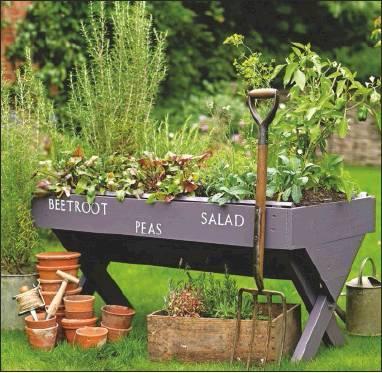Getting Into Gardening
As a Texas gardener, one of my favorite times of the year is mid-January. I know what you are thinking, “…um, Joe, we are not really growing anything in mid-January.”
That may be so, but this is the time of year we plan the spring garden, a time to dream of bounty to come and crisp veggies picked right off the vine! It is also time to start scouring seed catalogs in search of new favorites to try. My first seed catalog arrived right before Christmas and I have flipped through it so often that it already looks as old as last year’s catalogs!
It is often at this time of the year that the ‘big question’ usually comes up, “I want to plant a garden but what should I do first?”
I already have more than a dozen emails asking that very question! If you find yourself asking that question, then let me congratulate you on taking that first big step – planning to have a garden! Many folks who would like a home garden are quick to find a reason or three why they cannot plant one and thus really miss out on so much of what a garden has to offer. But by asking the ‘big question’ you are already on your way. Let me offer just a bit of help…
The weather outside might or might not still be frightful, but now is the best time to choose a site. Determine a garden spot that’s sunny most of the day, (keep in mind that bare winter trees will block sun in summer) and where it will be convenient to pop out and harvest something fresh for a meal. Access to tool storage, water, a compost pile and possibly electricity (for power tools) is also helpful.
Consider designating three or four distinct garden plots, which will allow you to rotate crops, a traditional method of plot management in which vegetables with like needs are grouped together. The three main groups are brassicas (cabbages, cauliflowers and Brussels sprouts), root crops (carrots, parsnips, beets and potatoes) and legumes (peas and beans). Make a fourth group with whatever miscellaneous tender vegetables you decide to grow, such as zucchini, sweet corn, celery and tomatoes. Divide your garden plot into three or four areas and rotate each crop group to a new plot every three or four years to avoid the buildup of pests and diseases that can occur when the same crops grow in the same spot year after year. Planning for crop rotation also allows you to prepare and feed soil in the ideal way for each crop.
It is always a great idea to Invest in your soil. To get the ‘dirt’ on your dirt, perform a soil test with your local agricultural extension office. This will tell you everything you need to know about what will grow there and how to improve it.
In the meantime, amend your soil with as much organic matter as possible, either by starting a compost pile or by adding bags of composted manure. This will give it a better texture, a diverse population of beneficial organisms, and more fertility.
Once you have decided where to plant it is time to think about what to plant. This is where the real dreaming takes place! One word of advice here, while you can certainly dream big it is important to start small. You can always add more later but if you start off too big you might find it more effort than you planned and end up discouraged, with no garden at all.
You ask, “What should I plant?” and I answer, “Well, what do you like to eat?”
You will want to take a mental inventory of the things you regularly eat. These are the vegetables you will want to plant the most of. If you don’t like eggplant, don’t plant eggplant, but if you can’t get enough tomatoes then plant a tomato heavy crop.
Also check with your local extension office or garden club to learn what grows well in your zone – Not everything grows good in every zone so consider growing things that grow best in your area for the best possible harvest. Also consider growing herbs for cooking or medicinal uses.
Take time to look through seed catalogs for ideas – I try to grow something new every year. Maybe it’s something I’ve never eaten before or maybe something I’ve never even heard of, this keeps gardening interesting and fun.
Another common question is “How much do I plant of each veggie?” Keep in mind the dream big but start small advice. Deciding how much of each vegetable to grow is something you will have to decide on and may be one of the more important decisions you make. Do you only want to grow enough to eat fresh vegetables when they’re in season or do you want enough to preserve for the entire year? You have to consider how many people you are feeding in your household and if you will be giving some away or selling some. Will you be succession planting for larger yearly yields or planting once and harvesting? All of these things are important factors when planning your garden.
One of the best things I think you can do is to try sketching out the garden plan. Just a good ol’ fashion pencil and paper are all you need. It doesn’t have to be complicated, simply laying out a pattern of your homestead on some paper and writing in where you will be planting certain things is a great start to your garden plan. Or use graph paper if you want to be a little more precise and sketch your garden beds to scale, then write in exactly what you will be planting in each bed. If the thought of ‘going old school’ is not your idea of fun, you can use software to layout your garden. There are several good software programs out there that will do just that. A good free online planner can be found here at www.gardeners.com/how-to/kitchen-garden-planner/kgp_home.html
I would also suggest that you keep a garden journal. Keeping a record of your garden will help you better plan next year’s garden. Recording things like when you planted certain plants, vegetables that did well and ones that didn’t, best tasting vegetables and all your successes and failures will serve as great reminder year after year and make for having your best possible garden for each and every season.
If you want some extra help with your garden, feel free to ask questions when you visit my website at www.gardeningaustin.com.
Most important of all is to remember what my great grandmother always told me, “Be a Doer! Planning is important but means nothing if you don’t carry out your plans.”
So, go ahead a dream, but be sure to execute your plan. Good advice that, both for the garden and for life!



